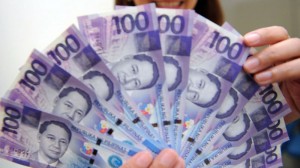MANILA, Philippines—The peso might depreciate to the 46 level against the US dollar by this yearend and further to 47 by the end of 2015 due to a “pretty loose” local monetary policy, the bottoming out of US interest rates and some oil price pressures, an economist from Swiss investment bank said.
In a teleconference on Monday, Singapore-based UBS senior economist for Asean Edward Teather also saw Philippine domestic economic growth easing slightly to 6.5 percent in 2014, which he said would still be “strong” before further softening next year to 5.8 percent, a pace which he said would be more “sustainable” for the country.
Teather further said monetary settings in the country have been “overly easy” in the last two years but with rising inflation pressures, he said the Bangko Sentral ng Pilipinas (BSP) would likely raise its overnight borrowing rate from the record-low level of 3.5 percent to 4 percent through 2014 and further to 5 percent through 2015.
Forecasts of the peso weakening against the US dollar through 2015, Teather said, were linked to a “pretty loose” monetary policy that has increased money supply and driven credit growth above 20 percent.
“That means to me that more peso is flying around and the investors in the Philippines who are very happy (with peso assets) may want to diversify their holdings a bit,” he said.
At the same time, he said the US Federal Reserve’s end of tapering policy and expectations of increase in US interest rates (seen by UBS to happen by the second quarter of 2015) would likely dampen demand for the peso. The increase in global oil prices is likewise seen as unfavorable for the local currency as the country will need more foreign exchange to import its oil requirements.
The last time the peso traded at the 46 levels against the US dollar was in 2010.
